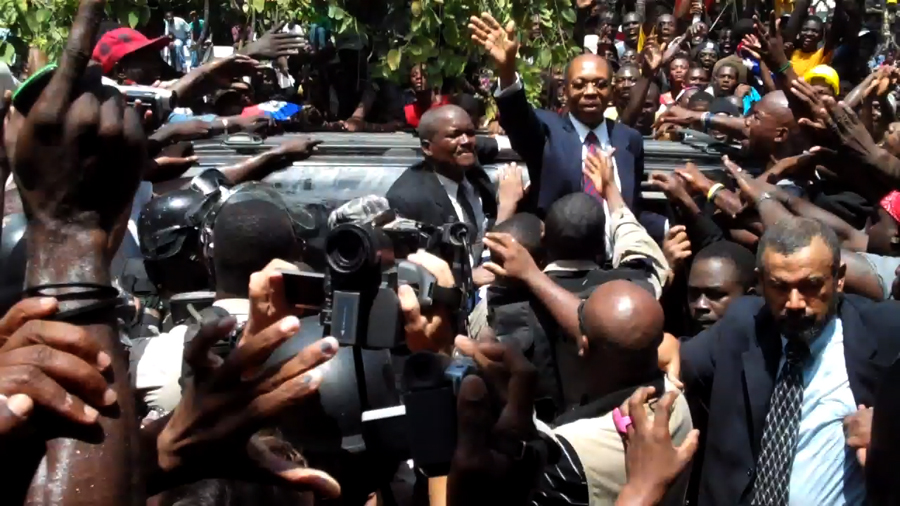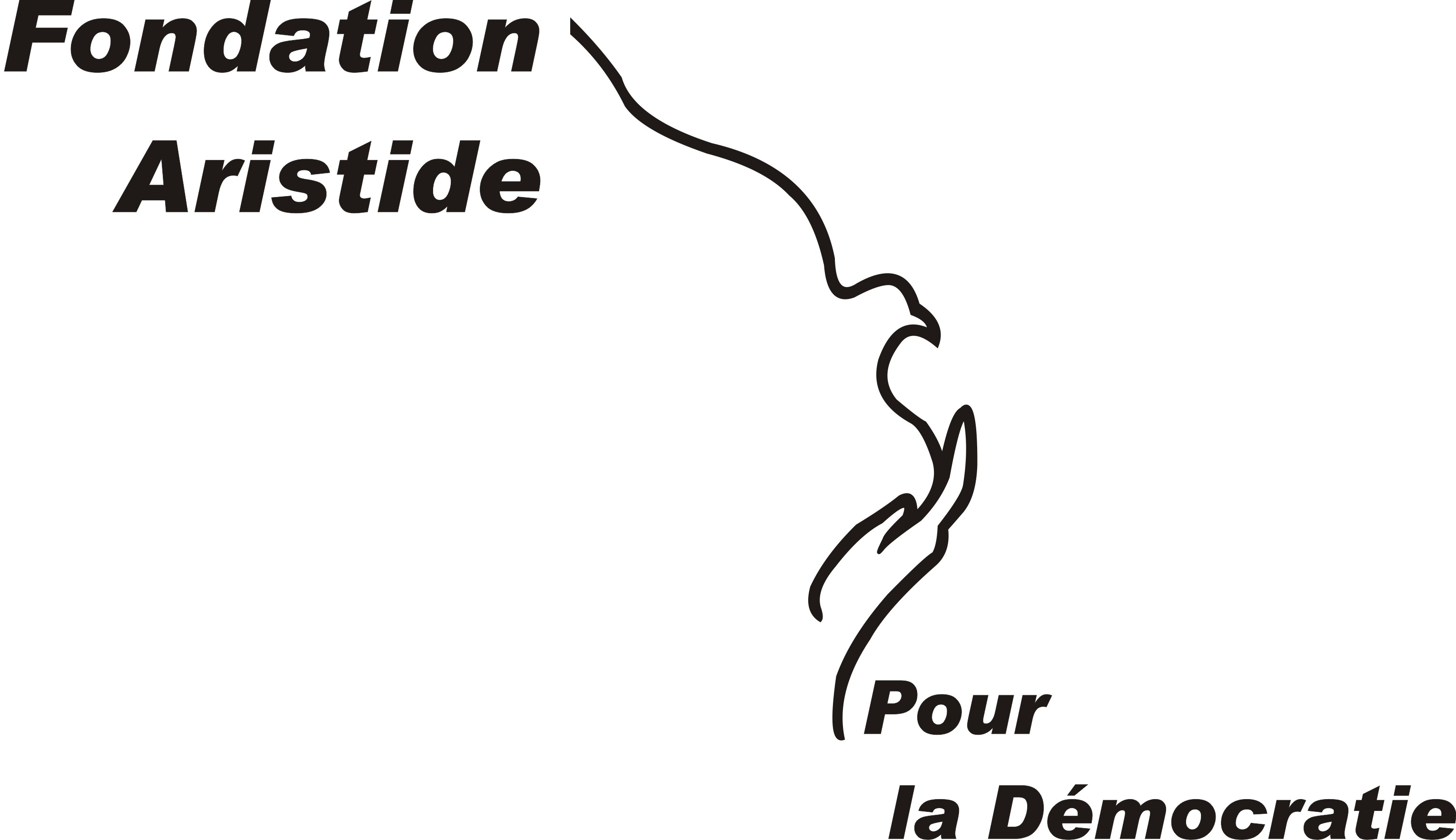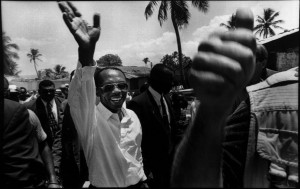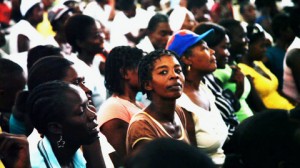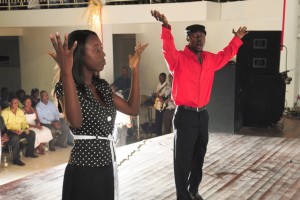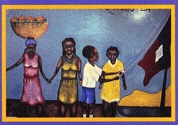Posted by lauraflynn on March 24, 2011 · Leave a Comment
On March 18, 2011, former President Jean-Bertrand Aristide and his family returned to Haiti after seven years in exile. He was greeted at the airport by tens of thousands of Haitians who then accompanied him to his house in Tabarre. In an outpouring of unrestrainable joy, they made his house their own, as you can see from the photos here.

People in the courtyard of Aristide's house surrounding the car as he emerged. Photio Paul Burke
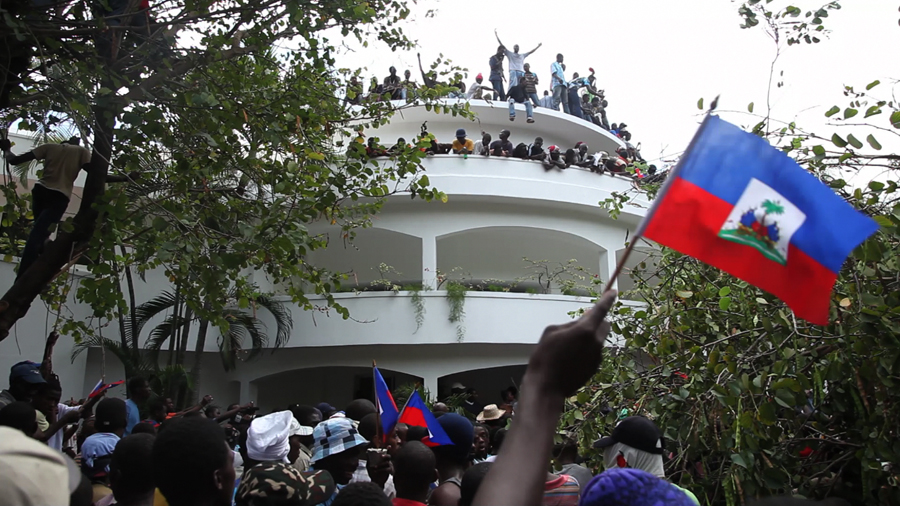
People welcoming Titid and his family at their house in Tabarre, photo Paul Burke

photo Paul Burke
From the airport just after he landed, Aristide addressed the Haitian people in a speech carried live on Haitian radio. He emphasized the need to move from a politics of exclusion to a one of inclusion of all social classes in the political, economic and social life of the nation. We reprint here the full text of speech as it was delivered primarily in Creole, with section in English, Spanish, Zulu, Swahili, and French.
Speech of Jean-Bertrand Aristide just after his arrival in Port-au-Prince, March 18, 2011
Sè m, Frè m, Onè ! Respè !
Otorite ki nan Leta Peyi d Ayiti,
Reprezantan Gouvènman Afrik Du Sud,
Anbasadè Matu ak Sè nou Matshidiso,
Otorite ki nan òganizasyon
Nasyonal kòm entènasyonal,
Sè m ak Frè m
Ki nan kat kwen peyi a ou aletranje,
Mwen kontan salye n nan lonbraj
Ayeropò Toussaint Louverture.
Sè m, Frè m,
Onè ! Respè !
Onè pou ou !
Respè pou Ayiti !
Ala kontan m kontan fè youn avèk
Minouche, Christine, Michaëlle pou
Salye ou e anbrase ou fratènèlman !
Sè m, Frè m,
Si w te ka poze men w sou kè mwen,
Ou ta santi kijan lap bat pi vit, pi plis
Pou di w : Bravo! Mèsi! Bravo! Mèsi!
Bravo pou kouraj ak entèlijans Pèp la !
Mèsi mil fwa pou akèy san parèy sa a !
Bravo pou tout bèl leson Pèp la deja bay !
Mèsi mil mil fwa pou bèl solèy solidarite
Ki pa te janm kouche dèyè mòn egzil sa a.
A warm welcome to :
Ira Kurzban, Dany Glover, Laura Flynn,
James Early, Selma James, widow of
CLR James, Margaret Prescod, Paul Burke.
Greetings to:
Honorable Deputy Maxine Waters,
Randall and Hezel Robinson,
Brian Cancanon, Claude Ribbe.
Peace to:
John Maxwell and the victims of
the disaster in Japan.
Onè ! Respè !
Onè pou ou e respè pou memwa
300.000 viktim tranbleman tè a !
Respè pou memwa tout moun ki
Viktim kolera ou katastwòf politik.
Men nan la men, bradsou bradsa,
Ann trese yon bèl kouwòn onè respè
Pou Rev Pè Gérard Jean-Juste ak
Tout lòt ewo ki sakrifye lavi yo nan
Defann diyite Ayiti ki malad grav.
Sè m, Frè m,
Pèmèt mwen pataje chalè remèsiman an
Ak anpil zanmi ki pa fèt an Ayiti, men
Ki renmen Pèp Ayisyen ak tout kè yo.
An 2004, gen nan yo ki te al chèche n
Nan peyi Afrik Santral pou akonpaye n
Rive nan peyi Jamayik an natandan
Prezidan Tabo Mbeki te chwazi depeche
Pwòp avyon prezidansyèl Lafrik Di Sid
Pou n te retounen nan bra manman Lafrik.
Yon gwo gwo mèsi pou Prezidan Zuma,
Prezidan Mbeki, Prezidan Mandela ak Tout lòt sè n ak frè n k ap viv nan peyi
Afrik Santral, Jamayik ak Afrik di Sid.
Jan m te di l, anvan n kite Afrik di Sid
Nan lang isiZoulou ak lang Swahili :
(IsiZoulou)
Yize iHaiti ikude naAfrika, asisoze sazikhohlwa
izimpande zamasiko ethu. Ngesikathi zonke
sizobatshela abantwana nezizukulu zethu :
Manikumbule lapho okoko bethu bazalelwe khona.
Niqubele ngokubona lendawo eya eAfrika.
Niqonde ngqo ngalo mgwaqo.
(Swahili)
Umoja ni nguvu,
Utengano ni udaifu.
Mtu ni watu.
Read more
Posted by lauraflynn on March 16, 2011 · Leave a Comment
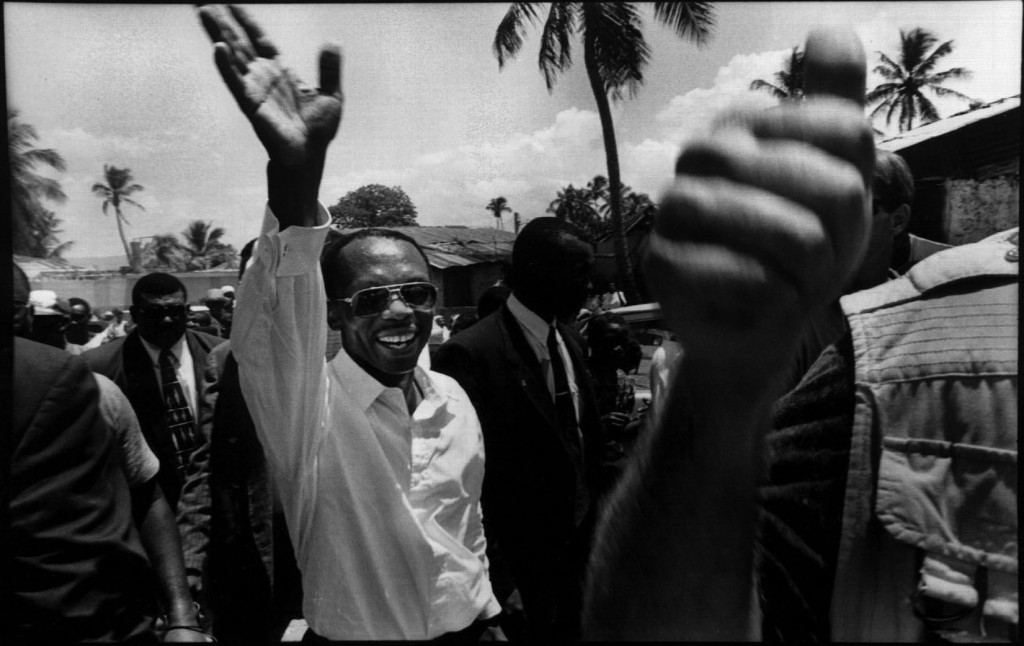
photo 1997©Jennifer Cheek Pantaléon
By Jean-Bertrand Aristide
Haiti’s devastating earthquake in January last year destroyed up to 5,000 schools and 80% of the country’s already weak university infrastructure. The primary school in Port-au-Prince that I attended as a small boy collapsed with more than 200 students inside. The weight of the state nursing school killed 150 future nurses. The state medical school was levelled. The exact number of students, teachers, professors, librarians, researchers, academics and administrators lost during those 65 seconds that irrevocably changed Haiti will never be known. But what we do know is that it cannot end there.
The exceptional resilience demonstrated by the Haitian people during and after the deadly earthquake reflects the intelligence and determination of parents, especially mothers, to keep their children alive and to give them a better future, and the eagerness of youth to learn – all this despite economic challenges, social barriers, political crisis, and psychological trauma. Even though their basic needs have increased exponentially, their readiness to learn is manifest. This natural thirst for education is the foundation for a successful learning process: what is freely learned is best learned.
Of course, learning is strengthened and solidified when it occurs in a safe, secure and normal environment. Hence our responsibility to promote social cohesion, democratic growth, sustainable development, self-determination; in short, the goals set forth for this new millennium. All of which represent steps towards a return to a better environment.
Education has been a top priority since the first Lavalas government – of which I was president – was sworn into officeunder Haiti’s amended democratic constitution on 7 February 1991 (and removed a few months later). More schools were built in the 10 years between 1994, when democracy was restored, and 2004 – when Haiti’s democracy was once again violated – than between 1804 to 1994: one hundred and ninety-five new primary schools and 104 new public high schools constructed and/or refurbished.
The 12 January earthquake largely spared the Foundation for Democracy I founded in 1996. Immediately following the quake, thousands accustomed to finding a democratic space to meet, debate and receive services, came seeking shelter and help. Haitian doctors who began their training at the foundation’s medical school rallied to organised clinics at the foundation and at tent camps across the capital. They continue to contribute tirelessly to the treatment of fellow Haitians who have been infected by cholera. Their presence is a pledge to reverse the dire ratio of one doctor for every 11,000 Haitians.
Youths, who through the years have participated in the foundation’s multiple literacy programmes, volunteered to operate mobile schools in these same tent camps. In partnership with a group from the University of Michigan in the US, post-traumatic counselling sessions were organised and university students trained to help themselves and to help fellow Haitians begin the long journey to healing. A year on, young people and students look to the foundation’s university to return to its educational vocation and help fill the gaping national hole left on the day the earth shook in Haiti.
Will the deepening destabilising political crisis in Haiti prevent students achieving academic success? I suppose most students, educators and parents are exhausted by the complexity of such a dramatic and painful crisis. But I am certain nothing can extinguish their collective thirst for education.
The renowned American poet and essayist, Ralph Waldo Emerson, wrote that “we learn geology the morning after the earthquake”. What we have learned in one long year of mourning after Haiti’s earthquake is that an exogenous plan of reconstruction – one that is profit-driven, exclusionary, conceived of and implemented by non-Haitians – cannot reconstruct Haiti. It is the solemn obligation of all Haitians to join in the reconstruction and to have a voice in the direction of the nation.
As I have not ceased to say since 29 February 2004, from exile in Central Africa, Jamaica and now South Africa, I will return to Haiti to the field I know best and love: education. We can only agree with the words of the great Nelson Mandela, that indeed education is a powerful weapon for changing the world.
(this piece was originally published in the Guardian on February 4, 2011, you can see the original here)
Posted by lauraflynn on March 13, 2011 · Leave a Comment

On February 23, the newly formed Youth League met for second day under the banner of Youth-Action-Integration-Cooperation. Over 1000 young people attended and spent the day working together to shape and define the future of the organization. An opening ceremony in the Auditorium of the Foundation began with a spiritual invocation, sung by Jean Marie Claude Germain, the current minister of the environment, accompanied by Kolonb Dor (the musical troupe of the Aristide Foundation), followed by the national anthem preformed by Kolonb Dor.
Minister Jean Marie Claude Germain, then gave a keynote speech on climate change and the future of the earth. Professor Wladimir N. Constant spoke on the leadership of the young.
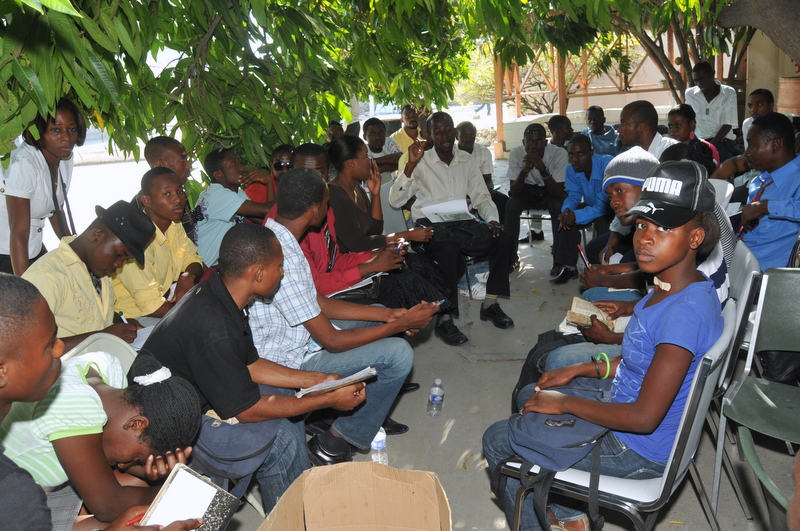
The young people assembled then broke up into working groups, and spent the rest of the day brainstorming ideas for potential activities the Youth League might undertake. The Ad-hoc committee of the Youth League which planned the days event organized breakout sessions in 10 areas of action: Pyschology, Justice & Human Rights, Culture, Communications, Political Science, Environment & Agriculture, Health, Educations, Sports, Cooperation and Integration. At the close of the day, each of the ten work groups formed a committee of 15 young people to lay out a plan of action over the next three months for the Youth League in each of the 10 sectors. A visiting delegation of students from California attended the event and offered their solidarity and support for the new Youth League.
Press Release in French:
Jèn/Aksyon/Entegrasyon/Koperasyon (JAEK)
Auditorium Fondation Aristide
23 Février 2011
La cérémonie a débuté par une prière rythmique avec comme texte de fond *DIEU TOUT-PUISSANT* chanté par l’artiste Ing. Jean Marie Claude Germain, actuel Ministre de l’Environnement et accompagné de la chorale Colombe d’Or de la Fondation Aristide.
Suivant l’ordre du jour, une jeune artiste solo membre de la chorale Colombe d’Or Mademoiselle Elmate Révolte a fait trembler l’auditoire en interprétant l’hymne national.
Il était prévu d’organiser la séance de formation en deux étapes : Une première étape pour exposer les thèmes faisant l’objet de la séance de formation.
1.- Rechauffement de la planète TERRE par l’Ing. Jean Marie Claude Germain.
2.- Leadership de la jeunesse par le Professeur Wladimir N. Constant.
La deuxième étape consistait à regrouper les jeunes en atelier. Le comité central Had Hoc formé de jeunes a pu organiser 10 ateliers en les identifiant par Secteur d’activité ou discipline. Il s’ágit :
1.- Secteur d’activité/Psychologie
2.- Secteur d’activité/Justice et Droits Humains
3.- Secteur d’activité/Culture
4.- Secteur d’activité/ Communication
5.- Secteur d’activité/ Science Politique
6.- Secteur d’activité/ Emvironnement et Agriculture
7.- Secteur d’activité/ Sports
8.- Secteur d’activité/ Education
9.- Secteur d’activité/ Santé
10.- Secteur d’activité/ Coopération et Intégration
En guise de résolution après les dicussions en atelier, 10 comités Had Hoc de 15 membres sont formés pour gérer pendant les 3 prochains mois qui suivent les destinés de la ligue de la jeunesse par secteur d’activité ou discipline.
Filed under Update · Tagged with
Next Page »

